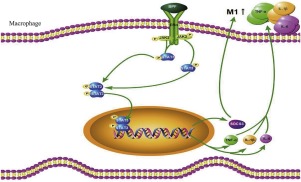当前位置:
X-MOL 学术
›
Toxicology
›
论文详情
Our official English website, www.x-mol.net, welcomes your feedback! (Note: you will need to create a separate account there.)
Estrogen receptor-regulated SOCS3 modulation via JAK2/STAT3 pathway is involved in BPF-induced M1 polarization of macrophages.
Toxicology ( IF 4.5 ) Pub Date : 2020-02-07 , DOI: 10.1016/j.tox.2020.152404 Mingjie Shi 1 , Zeheng Lin 1 , Lihe Ye 2 , Xinlin Chen 1 , Wenfeng Zhang 1 , Zihan Zhang 1 , Fei Luo 1 , Yungang Liu 3 , Ming Shi 1
Toxicology ( IF 4.5 ) Pub Date : 2020-02-07 , DOI: 10.1016/j.tox.2020.152404 Mingjie Shi 1 , Zeheng Lin 1 , Lihe Ye 2 , Xinlin Chen 1 , Wenfeng Zhang 1 , Zihan Zhang 1 , Fei Luo 1 , Yungang Liu 3 , Ming Shi 1
Affiliation

|
As an alternative to bisphenol A (BPA), bisphenol F (BPF) has been increasingly used in manufacturing various consumer products. Exposured to BPF may lead to imbalanced immune homeostasis, yet the underlying mechanisms have not been fully elucidated. The present study was aimed to investigate the effects of BPF on macrophages and the underlying mechanism in regard to its association with estrogen receptor (ER), janus kinase 2/signal transducer and activator of transcription 3/suppressor of cytokine signaling 3 (JAK2/STAT3/SOCS3) pathway. In this study, after treatment of RAW264.7 macrophages with BPF (0, 5, 10, 20 μM), the macrophage M1 polarization was promoted, and the gene expression of M1 functional markers and pro-inflammatory cytokines was upregulated, which suggested the involvement of a vicious circle associated with chronic inflammation. Moreover, BPF facilitated SOCS3 expression in the cells in a dose-dependent manner, via activation of the JAK2/STAT3 signaling pathway, which may promote the transcription of many pro-inflammatory factors. Additionally, the above effects of BPF were blocked by either JAK2/STAT3 inhibitor AG490 (10 μM) or ER antagonist ICI 182,780 (10 μM). Taken together, the results of this study indicate that BPF promotes macrophage polarization toward pro-inflammatory M1 subtype, through activation of the ER-JAK2/STAT3/SOCS3 signaling pathway. Our finding may provide a new insight into the link between bisphenol exposure and immune dysfunction.
中文翻译:

经由JAK2 / STAT3途径的雌激素受体调节的SOCS3调节与BPF诱导的巨噬细胞M1极化有关。
作为双酚A(BPA)的替代品,双酚F(BPF)已越来越多地用于制造各种消费品。暴露于BPF可能会导致免疫稳态失衡,但其潜在机制尚未完全阐明。本研究旨在探讨BPF对巨噬细胞的影响及其与雌激素受体(ER),janus激酶2 /信号转导子和转录激活因子3 /细胞因子信号转导抑制剂3(JAK2 / STAT3)相关的潜在机制/ SOCS3)路径。在这项研究中,用BPF(0、5、10、20μM)处理RAW264.7巨噬细胞后,促进了巨噬细胞M1极化,并且M1功能标记和促炎细胞因子的基因表达上调,这提示参与与慢性炎症相关的恶性循环。此外,BPF通过激活JAK2 / STAT3信号通路,以剂量依赖的方式促进了SOCS3在细胞中的表达,这可能促进了许多促炎因子的转录。另外,BAK的上述作用被JAK2 / STAT3抑制剂AG490(10μM)或ER拮抗剂ICI 182,780(10μM)阻断。两者合计,这项研究的结果表明,BPF通过激活ER-JAK2 / STAT3 / SOCS3信号通路,促进巨噬细胞向促炎性M1亚型的极化。我们的发现可能为双酚暴露与免疫功能障碍之间的联系提供新的见解。BPF的上述作用被JAK2 / STAT3抑制剂AG490(10μM)或ER拮抗剂ICI 182,780(10μM)阻断。两者合计,这项研究的结果表明,BPF通过激活ER-JAK2 / STAT3 / SOCS3信号通路,促进巨噬细胞向促炎性M1亚型的极化。我们的发现可能为双酚暴露与免疫功能障碍之间的联系提供新的见解。BPF的上述作用被JAK2 / STAT3抑制剂AG490(10μM)或ER拮抗剂ICI 182,780(10μM)阻断。两者合计,这项研究的结果表明,BPF通过激活ER-JAK2 / STAT3 / SOCS3信号通路,促进巨噬细胞向促炎性M1亚型的极化。我们的发现可能为双酚暴露与免疫功能障碍之间的联系提供新的见解。
更新日期:2020-02-07
中文翻译:

经由JAK2 / STAT3途径的雌激素受体调节的SOCS3调节与BPF诱导的巨噬细胞M1极化有关。
作为双酚A(BPA)的替代品,双酚F(BPF)已越来越多地用于制造各种消费品。暴露于BPF可能会导致免疫稳态失衡,但其潜在机制尚未完全阐明。本研究旨在探讨BPF对巨噬细胞的影响及其与雌激素受体(ER),janus激酶2 /信号转导子和转录激活因子3 /细胞因子信号转导抑制剂3(JAK2 / STAT3)相关的潜在机制/ SOCS3)路径。在这项研究中,用BPF(0、5、10、20μM)处理RAW264.7巨噬细胞后,促进了巨噬细胞M1极化,并且M1功能标记和促炎细胞因子的基因表达上调,这提示参与与慢性炎症相关的恶性循环。此外,BPF通过激活JAK2 / STAT3信号通路,以剂量依赖的方式促进了SOCS3在细胞中的表达,这可能促进了许多促炎因子的转录。另外,BAK的上述作用被JAK2 / STAT3抑制剂AG490(10μM)或ER拮抗剂ICI 182,780(10μM)阻断。两者合计,这项研究的结果表明,BPF通过激活ER-JAK2 / STAT3 / SOCS3信号通路,促进巨噬细胞向促炎性M1亚型的极化。我们的发现可能为双酚暴露与免疫功能障碍之间的联系提供新的见解。BPF的上述作用被JAK2 / STAT3抑制剂AG490(10μM)或ER拮抗剂ICI 182,780(10μM)阻断。两者合计,这项研究的结果表明,BPF通过激活ER-JAK2 / STAT3 / SOCS3信号通路,促进巨噬细胞向促炎性M1亚型的极化。我们的发现可能为双酚暴露与免疫功能障碍之间的联系提供新的见解。BPF的上述作用被JAK2 / STAT3抑制剂AG490(10μM)或ER拮抗剂ICI 182,780(10μM)阻断。两者合计,这项研究的结果表明,BPF通过激活ER-JAK2 / STAT3 / SOCS3信号通路,促进巨噬细胞向促炎性M1亚型的极化。我们的发现可能为双酚暴露与免疫功能障碍之间的联系提供新的见解。


























 京公网安备 11010802027423号
京公网安备 11010802027423号